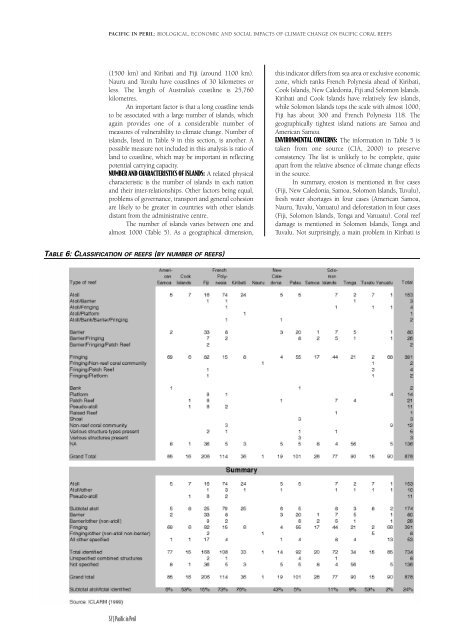Pacific in Peril - Greenpeace
Pacific in Peril - Greenpeace
Pacific in Peril - Greenpeace
Create successful ePaper yourself
Turn your PDF publications into a flip-book with our unique Google optimized e-Paper software.
PACIFIC IN PERIL: BIOLOGICAL, ECONOMIC AND SOCIAL IMPACTS OF CLIMATE CHANGE ON PACIFIC CORAL REEFS<br />
(1500 km) and Kiribati and Fiji (around 1100 km).<br />
Nauru and Tuvalu have coastl<strong>in</strong>es of 30 kilometres or<br />
less. The length of Australia’s coastl<strong>in</strong>e is 25,760<br />
kilometres.<br />
An important factor is that a long coastl<strong>in</strong>e tends<br />
to be associated with a large number of islands, which<br />
aga<strong>in</strong> provides one of a considerable number of<br />
measures of vulnerability to climate change. Number of<br />
islands, listed <strong>in</strong> Table 9 <strong>in</strong> this section, is another. A<br />
possible measure not <strong>in</strong>cluded <strong>in</strong> this analysis is ratio of<br />
land to coastl<strong>in</strong>e, which may be important <strong>in</strong> reflect<strong>in</strong>g<br />
potential carry<strong>in</strong>g capacity.<br />
NUMBER AND CHARACTERISTICS OF ISLANDS: A related physical<br />
characteristic is the number of islands <strong>in</strong> each nation<br />
and their <strong>in</strong>ter-relationships. Other factors be<strong>in</strong>g equal,<br />
problems of governance, transport and general cohesion<br />
are likely to be greater <strong>in</strong> countries with other islands<br />
distant from the adm<strong>in</strong>istrative centre.<br />
The number of islands varies between one and<br />
almost 1000 (Table 5). As a geographical dimension,<br />
TABLE 6: CLASSIFICATION OF REEFS (BY NUMBER OF REEFS)<br />
32 | <strong>Pacific</strong> <strong>in</strong> <strong>Peril</strong><br />
this <strong>in</strong>dicator differs from sea area or exclusive economic<br />
zone, which ranks French Polynesia ahead of Kiribati,<br />
Cook Islands, New Caledonia, Fiji and Solomon Islands.<br />
Kiribati and Cook Islands have relatively few islands,<br />
while Solomon Islands tops the scale with almost 1000,<br />
Fiji has about 300 and French Polynesia 118. The<br />
geographically tightest island nations are Samoa and<br />
American Samoa.<br />
ENVIRONMENTAL CONCERNS: The <strong>in</strong>formation <strong>in</strong> Table 5 is<br />
taken from one source (CIA, 2000) to preserve<br />
consistency. The list is unlikely to be complete, quite<br />
apart from the relative absence of climate change effects<br />
<strong>in</strong> the source.<br />
In summary, erosion is mentioned <strong>in</strong> five cases<br />
(Fiji, New Caledonia, Samoa, Solomon Islands, Tuvalu),<br />
fresh water shortages <strong>in</strong> four cases (American Samoa,<br />
Nauru, Tuvalu, Vanuatu) and deforestation <strong>in</strong> four cases<br />
(Fiji, Solomon Islands, Tonga and Vanuatu). Coral reef<br />
damage is mentioned <strong>in</strong> Solomon Islands, Tonga and<br />
Tuvalu. Not surpris<strong>in</strong>gly, a ma<strong>in</strong> problem <strong>in</strong> Kiribati is


